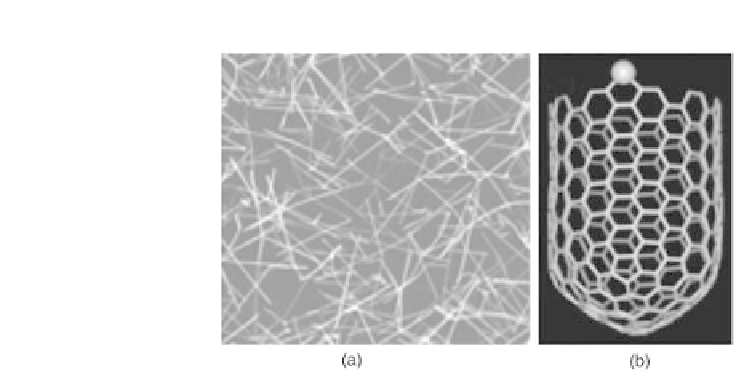Information Technology Reference
In-Depth Information
Figure
17.1.
(a) SEM image of In
2
O
3
nanowires. (b) Schematic diagram of a single-
walled carbon nanotube.
Carbon nanotubes are sheets of graphite rolled into seamless cylinders
(Fig. 17.1b) with diameters 1-2
l
nm and micron scale lengths. This one-dimen-
sional structure exhibits useful electronic and mechanical properties, behaving as
metals, semimetals, or semiconductors. Carbon nanotubes can carry a current
density up to 109 ampere/cm
2
and electrons can move ballistically in a carbon
nanotube without any significant scattering even at room temperature. In
addition, carbon nanotubes possess very high thermal conductivity and significant
mechanical strength. These properties make them ideal to work as synaptic
connections between artificial neurons, as they can conduct sufficient current
without generating significant heat, and the high thermal conductivity and
mechanical strength guarantee good heat dissipation and robust operation. In
comparison, interconnects made of top-down fabricated metal electrodes may
never reach a width of 1-2
l
nm due to issues like the finite grain size and insta-
bility related to the grain wall migration. Following Zhou's previous work on
carbon nanotube p-n junctions [56], mechanical switches, and chemical sensors
[57], Zhou's group has carried out significant work, including the demonstration
of the complementary nanotube inverter [58], band engineering of nanotube
transistors via selected-area chemical doping [59], and template-free directional
growth of nanotubes on a- and r-plane sapphire substrates [60, 61].
Single-walled carbon nanotubes avoid most of the fundamental scaling
limitations of silicon devices, and appear to be an appropriate technology for a
synthetic cortex. Liu, Han, and Zhou have demonstrated directional growth of
high-density single-walled carbon nanotubes on a- and r-plane sapphire substrates
over large areas [60, 62]. They have developed a novel nanotube-on-insulator
(NOI) approach for producing high-yield nanotube devices based on aligned
single-walled carbon nanotubes. Also, they have developed a way to transfer these
aligned nanotube arrays to flexible substrates.






Search WWH ::

Custom Search